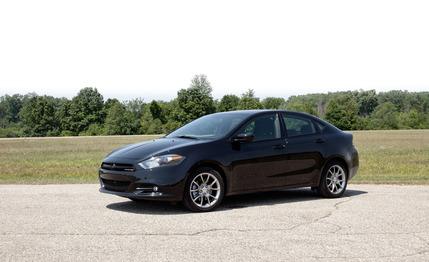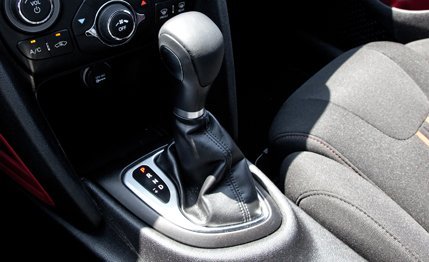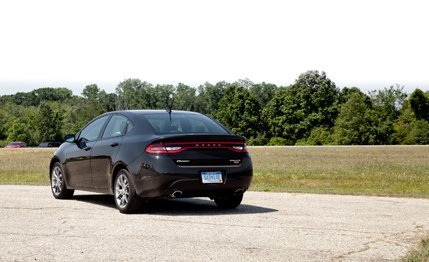 First Drive Review
First Drive Review
As the sage late-20th-century philosophy and electronic-music collective known as Devo once opined, “Freedom of choice/Is what you got.” Looking at the specs for the 2013 Dodge Dart, it seems this couplet still runs through the minds of at least a few Chrysler product planners. How else can one explain the bewildering number of trim-level and powertrain combinations available for Dodge’s much-ballyhooed four-door upstart?
Choose Your Own Powertrain
For people keeping score, the Dart comes in four trim levels: the SE, the SXT, the Rallye, and the Limited. Two more, the R/T and the Aero, are scheduled for later in the year. A choice of three four-cylinder engines—a 1.4-liter MultiAir turbo, a 2.0-liter Tigershark, and a 2.4-liter MultiAir 2 Tigershark—are accompanied by three transmission choices. A six-speed manual transmission is standard across the board, and a Hyundai-sourced six-speed automatic is available with either of the Tigershark fours; the six-speed “dual dry-clutch transmission,” or DDCT, can be paired only with the 1.4-liter turbo. You can order a Dart à la carte up to a point, although the dual-clutch tranny with 1.4-liter combo is restricted to the SXT, Rallye, and Limited trims. Got it?
We sampled the dual-clutch box in a Dart Rallye—technically, a preproduction example—that sat baking in 104-degree heat, its black exterior paint and interior accouterments acting like rolling heat sinks. We’ve already tested the 1.4-liter turbo with the manual, but this was our initial crack at the car equipped with Chrysler’s first dual-clutch. We weren’t about to let a pesky heat advisory keep us from wringing it out like a sweat-drenched bandana, and besides, the Dart’s climate control had us chilled in no time.

The short story is this: slow and smooth. Placed in the manual sport mode and with a foot to the floor, the revs dutifully climb toward the redline—no zinging here. Tugging the shift lever rearward (there are no wheel-mounted paddles) at approximately 6000 rpm executes upshifts with something resembling indifference. Anything past that, and the computer upshifts automatically. During shifts, there is no shock through the chassis or barking or burping from the exhaust. Vehicle and engine speed simply accrue quite linearly, indicating that Chrysler put some real effort into calibrating the ratios. (The box is sourced from Fiat/Alfa but tuned in America for the Dart.) We’re estimating the 1.4 with dual-clutch combo will return 27 mpg in the city and 37 on the highway.
At low speeds and in stop-and-go situations, the transmission exhibited none of the stuttering or indecision of the dual-clutch PowerShift in the current Ford Focus, and the DDCT’s shifts are quicker and less intrusive than those of Hyundai’s DCT. But how about a dual-clutch we quite like? Compared with VW’s excellent DSG, the Chrysler unit swaps gears with far less authority. Overall, the DDCT is the most like a traditional torque-converter automatic of the dual-clutch units we’ve sampled to date.
Automatic for the People
Which makes sense. According to Chrysler, its engineers were more concerned with the DDCT’s fully automatic mode. The goal was operation as similar as possible to that of the regular autoboxes Americans love so dearly. This is the same mind-set that drove Ford’s PowerShift calibrations; the blue oval wasn’t as successful, however. In the Dart, you simply don’t feel any sensation that indicate the car has switched gears; you only hear the change in engine note and see the tach needle drop.

It wasn’t all sunshine: A particularly annoying foible we experienced multiple times was an unintended double-shift. Due to a slight delay between lever input and transmission response—and because, as mentioned, the gearbox will still shift at redline in manual mode—we found our manually executed shifts accompanied by a second, computer-directed swap milliseconds later. For example, you’re in second and end up in fourth when you wanted third. Chrysler says it’s still working on the final programming, but we’re thinking enthusiasts will want to stick with the manual.
Otherwise, the Dart as equipped with the 160-hp turbo four exhibits nearly identical handling characteristics to those of its non-DDCT sibling. Again, you can read that test here, but to recap, the steering is linear, the ride is quiet, and the interior is comfortable and spacious.
Chrysler has a lot riding on the Dart and has stuffed the order sheet chock-full of options and model configurations in an attempt to lure buyers from all corners of the compact segment. This particular combination isn’t necessarily our favorite, but it’s likely to satisfy the auto-shifting heart of the market.